154 scholarly books by Diaphanes and 9
have author last names that start with D
154 scholarly books by Diaphanes and 9
154 scholarly books by Diaphanes
9 have author last names that start with D have author last names that start with D
9 have author last names that start with D have author last names that start with D
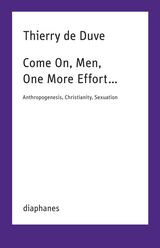
Come On, Men, One More Effort …
Anthropogenesis, Christianity, Sexuation
Thierry de Duve
Diaphanes, 2024
A theoretical exploration of possible ways out of concepts adopted by the Enlightenment.
Thierry de Duve outlines the main features of a critical theory of male, all-too-male sexuation and cross-gender emancipation, drawing on Marcel Gauchet’s theses on Christianity as an exit from religion, Jacques Lacan’s algebra of desire, and Geneviève Morel’s analysis of the “law of the mother.”
Wouldn’t it have required more than the translation of the three Christian maxims “faith, hope, love” into the revolutionary maxims “liberté, egalité, fraternité?” Is there more to the knot of incarnation, fatherhood, and the cult of Mary than just Christian mysticism? Can the uncertainty of fatherhood become an act of faith that acknowledges a fundamental uncertainty?
Come On, Men, One More Effort… explores ways out of the dead end of political concepts adopted by the Enlightenment and their continued impact today, since the only possibility seems to be to embrace the religious and reject it at the same time.
Thierry de Duve outlines the main features of a critical theory of male, all-too-male sexuation and cross-gender emancipation, drawing on Marcel Gauchet’s theses on Christianity as an exit from religion, Jacques Lacan’s algebra of desire, and Geneviève Morel’s analysis of the “law of the mother.”
Wouldn’t it have required more than the translation of the three Christian maxims “faith, hope, love” into the revolutionary maxims “liberté, egalité, fraternité?” Is there more to the knot of incarnation, fatherhood, and the cult of Mary than just Christian mysticism? Can the uncertainty of fatherhood become an act of faith that acknowledges a fundamental uncertainty?
Come On, Men, One More Effort… explores ways out of the dead end of political concepts adopted by the Enlightenment and their continued impact today, since the only possibility seems to be to embrace the religious and reject it at the same time.
[more]
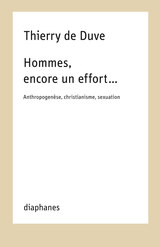
Hommes, encore un effort…
Anthropogenèse, christianisme, sexuation
Thierry de Duve
Diaphanes, 2023
Dans ce petit livre intempestif arc-bouté à la conviction selon laquelle « le christianisme est la religion de la sortie de la religion » (Marcel Gauchet), Thierry de Duve sort des disciplines qui sont les siennes, l’esthétique et histoire de l’art, pour aborder deux questions anthropologiques que la mutation de l’ordre symbolique en cours rend pressantes : la différence des sexes, qu’il envisage par le biais de l’incertitude de la paternité, et l’avenir de la politique d’émancipation, qu’il ancre à la naissance prématurée des enfants humains. Le ton de ce livre est une certaine effronterie respectueuse par laquelle de Duve engage un dialogue imaginaire avec quelques grandes figures intellectuelles, parmi lesquelles Françoise Héritier, Alain Badiou, Georges Duby, Marcel Gauchet et, last but not least, Jacques Lacan.
[more]
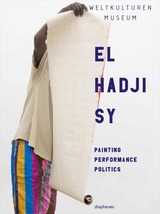
El Hadji Sy
Painting, Performance, Politics
Clémentine Deliss
Diaphanes, 2015
El Hadji Sy: Painting, Performance, Politics offers the first art-historical survey on the multidimensional work of Senegalese artist, curator, and cultural activist El Hadji Sy. Spanning thirty years of his practice as a painter, performance artist, and founder of numerous artists’ collectives and workshops in Dakar (Laboratoire AGIT’ART, Tenq, and Village des Arts), it provides unprecedented insight into the conceptual and aesthetic framework of a major living artist and curator from West Africa.
With newly commissioned essays and interviews by Hans Belting, Clémentine Deliss, Mamadou Diouf, Julia Grosse, Yvette Mutumba, Philippe Pirotte, and Manon Schwich, the book is presented in a bilingual English-German edition and also contains unique archival material, including manifestos, documents, and over four hundred illustrations.
With newly commissioned essays and interviews by Hans Belting, Clémentine Deliss, Mamadou Diouf, Julia Grosse, Yvette Mutumba, Philippe Pirotte, and Manon Schwich, the book is presented in a bilingual English-German edition and also contains unique archival material, including manifestos, documents, and over four hundred illustrations.
[more]
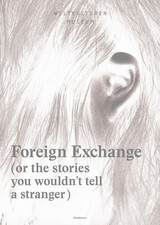
Foreign Exchange
(Or the Stories You Wouldn't Tell a Stranger)
Clémentine Deliss
Diaphanes, 2014
Founded in 1904, Frankfurt’s Weltkulturen Museum houses a remarkable collection of ethnographic artifacts from Asia, Africa, Oceania, and the Americas, with the aims of advancing public education and fostering innovative anthropological research across a wide variety of contemporary artistic practices.
Developed through artistic research in the Weltkulturen Museum’s Weltkulturen Labor research lab, Foreign Exchange raises questions about the relationship between the museum’s educational and scientific aims and global trade. Together, essays by anthropologists, art historians, artists, and curators form an extended conversation around the historical accumulation and commodification of artifacts and, in particular, the representation of the human body in ethnographic photographs. Rounding out the volume are many previously unpublished photographs of works discussed. Contributing authors and artist include Peggy Buth, Minerva Cuevas, Gabriel Gbadamosi, David Lau, Tom McCarthy, David Weber-Krebs, and Luke Willis-Thompson.
Developed through artistic research in the Weltkulturen Museum’s Weltkulturen Labor research lab, Foreign Exchange raises questions about the relationship between the museum’s educational and scientific aims and global trade. Together, essays by anthropologists, art historians, artists, and curators form an extended conversation around the historical accumulation and commodification of artifacts and, in particular, the representation of the human body in ethnographic photographs. Rounding out the volume are many previously unpublished photographs of works discussed. Contributing authors and artist include Peggy Buth, Minerva Cuevas, Gabriel Gbadamosi, David Lau, Tom McCarthy, David Weber-Krebs, and Luke Willis-Thompson.
[more]
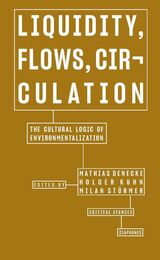
Liquidity, Flows, Circulation
The Cultural Logic of Environmentalization
Mathias Denecke
Diaphanes, 2022
Interdisciplinary studies that combine the current of materialist thinking with discussions of ecologies and environmentalization.
Placed at the intersection of art, media, and cultural studies as well as economic theory, Liquidity, Flows, Circulation investigates the cultural logic of environmentalization. As flows, circulations, and liquidity resurface in all aspects of recent culture and contemporary art, this volume investigates the hypothesis of a genuine cultural logic of environmentalization through these three concepts.
It thus brings together two areas of research that have been largely separate. On the one hand, this volume takes up discussions about ecologies with and without nature and environmentalization as a contemporary form of power and capital. On the other hand, it takes its cue from Fredric Jameson’s notion that each stage of capitalism is accompanied by a genuine cultural logic. The volume introduces this current of materialist thinking into the ongoing discussions of ecologies and environmentalization. By analyzing contemporary art, architecture, theater, films, and literature, the fifteen contributions by scholars and artists explore different fields where liquid forms, semantics flow, or processes of circulation emerge as a contemporary cultural logic.
Placed at the intersection of art, media, and cultural studies as well as economic theory, Liquidity, Flows, Circulation investigates the cultural logic of environmentalization. As flows, circulations, and liquidity resurface in all aspects of recent culture and contemporary art, this volume investigates the hypothesis of a genuine cultural logic of environmentalization through these three concepts.
It thus brings together two areas of research that have been largely separate. On the one hand, this volume takes up discussions about ecologies with and without nature and environmentalization as a contemporary form of power and capital. On the other hand, it takes its cue from Fredric Jameson’s notion that each stage of capitalism is accompanied by a genuine cultural logic. The volume introduces this current of materialist thinking into the ongoing discussions of ecologies and environmentalization. By analyzing contemporary art, architecture, theater, films, and literature, the fifteen contributions by scholars and artists explore different fields where liquid forms, semantics flow, or processes of circulation emerge as a contemporary cultural logic.
[more]
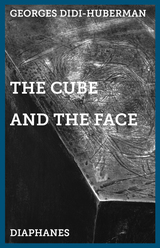
The Cube and the Face
Around a Sculpture by Alberto Giacometti
Georges Didi-Huberman
Diaphanes, 2015
Alberto Giacometti’s 1934 Cube stands apart for many as atypical of the Swiss artist, the only abstract sculptural work in a wide oeuvre that otherwise had as its objective the exploration of reality.
With The Cube and the Face, renowned French art historian and philosopher Georges Didi-Huberman has conducted a careful analysis of Cube, consulting the artist’s sketches, etchings, texts, and other sculptural works in the years just before and after Cube was created. Cube, he finds, is indeed exceptional—a work without clear stylistic kinship to the works that came before or after it. At the same time, Didi-Huberman shows, Cube marks the transition between the artist’s surrealist and realist phases and contains many elements of Giacometti’s aesthetic consciousness, including his interest in dimensionality, the relation of the body to geometry, and the portrait—or what Didi-Huberman terms “abstract anthropomorphism.” Drawing on Freud, Bataille, Leiris, and others Giacometti counted as influence, Didi-Huberman presents fans and collectors of Giacometti’s art with a new approach to transitional work.
With The Cube and the Face, renowned French art historian and philosopher Georges Didi-Huberman has conducted a careful analysis of Cube, consulting the artist’s sketches, etchings, texts, and other sculptural works in the years just before and after Cube was created. Cube, he finds, is indeed exceptional—a work without clear stylistic kinship to the works that came before or after it. At the same time, Didi-Huberman shows, Cube marks the transition between the artist’s surrealist and realist phases and contains many elements of Giacometti’s aesthetic consciousness, including his interest in dimensionality, the relation of the body to geometry, and the portrait—or what Didi-Huberman terms “abstract anthropomorphism.” Drawing on Freud, Bataille, Leiris, and others Giacometti counted as influence, Didi-Huberman presents fans and collectors of Giacometti’s art with a new approach to transitional work.
[more]
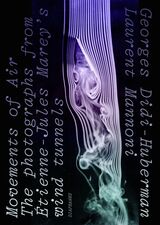
Movements of Air
The Photographs from Étienne-Jules Marey’s Wind Tunnels
Georges Didi-Huberman
Diaphanes, 2022
Two important essays on Étienne-Jules Marey published for the first time in English alongside his breathtaking images of moving air and smoke.
Featuring more than one hundred and fifty photographs and images, Movements of Air reprints the breathtaking pictures of Étienne-Jules Marey—images captured between 1899 and 1901 during his scientific experiments with moving air and smoke—and complements them with essays by Georges Didi-Huberman and Laurent Mannoni.
Mannoni begins by reflecting on Marey’s experimental approach. As the founder of the “graphic method,” Marey was also the developer of an aerodynamic wind tunnel. His experiments’ photographs of fluid motion introduced a whole world of movements and turbulences, and fluids, and influenced generations of scientists and artists alike. Didi-Huberman expands on the philosophical debates surrounding these aesthetically and technically instructive images. Even though Marey’s main interest was graphic information, Didi-Huberman shows us how the flow of all things drew this ingenious experimenter to a photographic practice that creates drags, streaks, expansions, and visual dances. Marey’s wind tunnel photographs were also themselves causes of turbulence in the history of images. The artists Dombois and Oeschger explore these “graphical” vortices of the last 120 years, providing at the end of the book a collage from historical and contemporary material interlaced with their own image-making in Dombois’s wind tunnel at the Zurich University of the Arts.
Featuring more than one hundred and fifty photographs and images, Movements of Air reprints the breathtaking pictures of Étienne-Jules Marey—images captured between 1899 and 1901 during his scientific experiments with moving air and smoke—and complements them with essays by Georges Didi-Huberman and Laurent Mannoni.
Mannoni begins by reflecting on Marey’s experimental approach. As the founder of the “graphic method,” Marey was also the developer of an aerodynamic wind tunnel. His experiments’ photographs of fluid motion introduced a whole world of movements and turbulences, and fluids, and influenced generations of scientists and artists alike. Didi-Huberman expands on the philosophical debates surrounding these aesthetically and technically instructive images. Even though Marey’s main interest was graphic information, Didi-Huberman shows us how the flow of all things drew this ingenious experimenter to a photographic practice that creates drags, streaks, expansions, and visual dances. Marey’s wind tunnel photographs were also themselves causes of turbulence in the history of images. The artists Dombois and Oeschger explore these “graphical” vortices of the last 120 years, providing at the end of the book a collage from historical and contemporary material interlaced with their own image-making in Dombois’s wind tunnel at the Zurich University of the Arts.
[more]
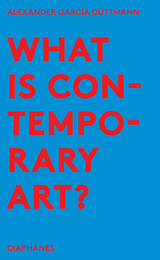
Alexander García Düttmann
Diaphanes
Art today is often practiced in perfect conformity with the neoliberal zeitgeist, often even denying its own radical potential. What is Contemporary Art? lucidly examines the relationship between art and politics in our time. Addressing the heart of the political-aesthetic debate, Alexander Garcia Düttmann shows how the radicality of contemporary art actually serves to strengthen today’s political ideologies, ultimately frustrating rather than propelling real social change as a result.
[more]
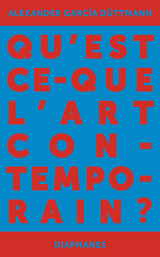
Qu’est-ce que l’art contemporain ?
Alexander García Düttmann
Diaphanes, 2019
Il est difficile de concevoir un art qui soit aussi étroitement lié à son présent que ne l’est l’art contemporain. En effet, l’art contemporain est issu d’une rupture inouïe avec les pratiques artistiques du passé. Il semble prendre son point de départ dans une profonde amnésie par rapport à ce qui le précède. Les distinctions esthétiques traditionnelles, entre forme et contenu, autonomie et hétéronomie, ou oeuvre et critique, ne sont plus pertinentes quand il s’agit de cet art. Mais qu’est-ce qu’alors que l’art contemporain? Cette question a pu être posée par l’historien, le théoricien, voire le sociologue de l’art. Mais elle n’a pas encore été soulevée comme question philosophique – comme question qui cherche à établir l’essence de l’art contemporain. La réponse donnée, dans ce livre, à ladite question est double. D’une part, elle est positive: dans son essence, l’art contemporain est la fiction d’un pur faire. D’autre part, elle est négative: l’art contemporain est le site où se révèle comme nulle part ailleurs l’idéologie politique du capitalisme néolibéral.
[more]
READERS
Browse our collection.
PUBLISHERS
See BiblioVault's publisher services.
STUDENT SERVICES
Files for college accessibility offices.
UChicago Accessibility Resources
home | accessibility | search | about | contact us
BiblioVault ® 2001 - 2024
The University of Chicago Press









